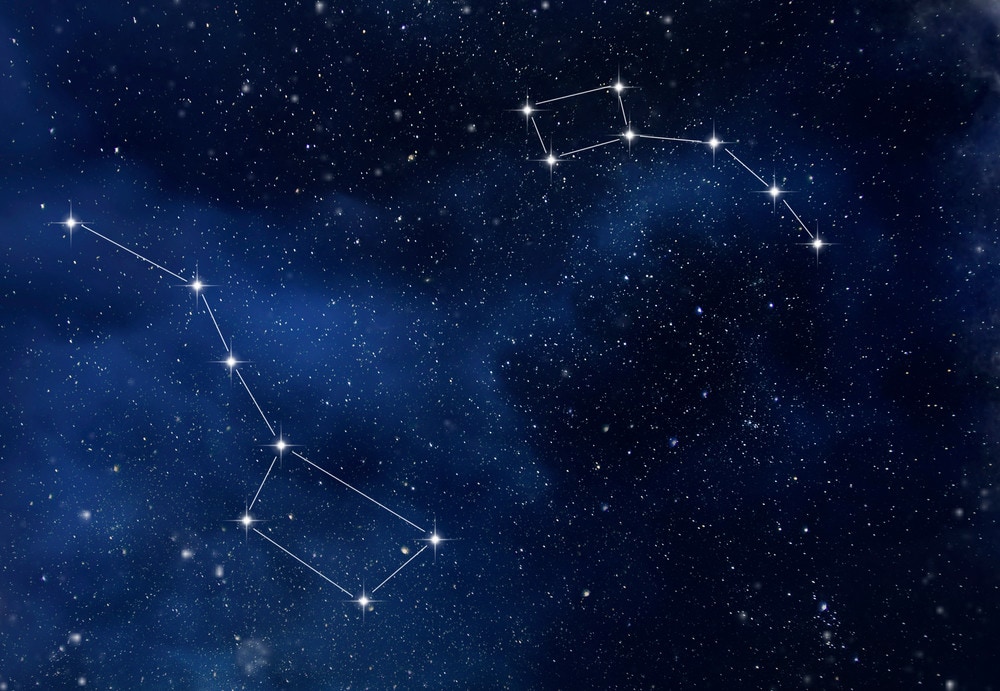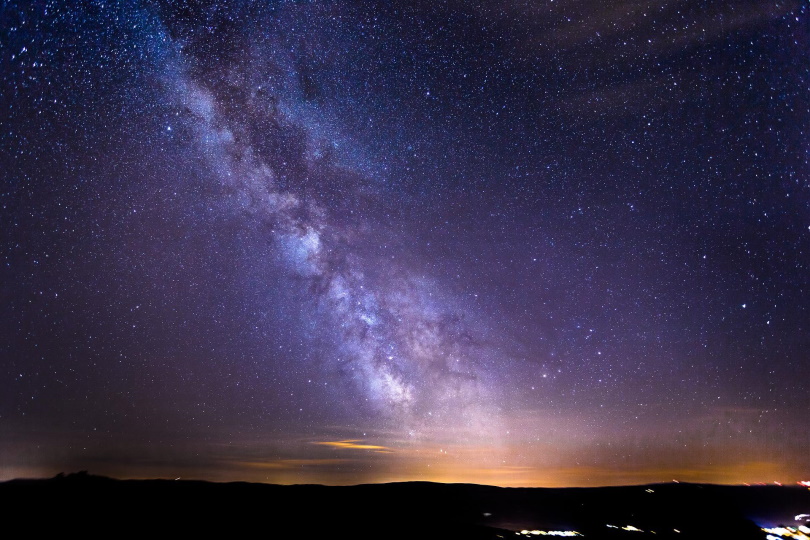Is the Big Dipper a Constellation? Mythology, Facts & FAQs
Last Updated on

The Big Dipper is in the Ursa Major constellation, also known as the Great Bear. It is one of the most recognizable star patterns in the sky and has been used for navigation and stargazing for centuries.
Rather than a constellation, the Big Dipper is an asterism. It contains seven stars that form a “dipper” or “ladle” shape. The stars of the Big Dipper are some of the brightest in the sky and are close to each other in terms of distance from Earth.
The Big Dipper is useful for finding other stars and constellations in the night sky. For example, the two stars at the end of the “ladle” point to Polaris, the North Star. Here’s more about this asterism.

What Is an Asterism?
In astronomy, an asterism is a pattern of stars that is not officially recognized as a constellation. For example, the Big Dipper forms a pattern of stars in the Ursa Major constellation. Other asterisms include the Pleiades and Orion’s Belt.
- Alkaid (Eta Ursae Majoris)
- Mizar (Zeta Ursae Majoris)
- Alioth (Epsilon Ursae Majoris)
- Dubhe (Alpha Ursae Majoris)
- and Merak (Beta Ursae Majoris)
- Megrez (Delta Ursae Majoris)
- Phecda (Gamma Ursae Majoris)
Where Is the Big Dipper Located?

The Ursa Major is in the NQ2 or the second quadrant of the Northern Hemisphere. The Big Dipper asterism is located within this constellation. Therefore, it is visible all year round in the Northern Hemisphere. But the best time to see it is in April during the evenings.
Since the asterism is circumpolar, it never fades from the horizon. Thus, you can see it throughout the year. However, it might seem like the asterism is rotating counterclockwise. But that’s only due to the Earth’s rotation.
The Big Dipper is visible in the north of the sky for most geographical locations. However, it may be in the northwest or northeast, depending on what time of the year it is.
During spring, you can see it in the northeast. It’s most visible at around 10:00 PM and travels highest across the sky. In summer, you can see it in the northwest of the sky.
People in the Southern Hemisphere may have difficulty finding this asterism due to its location in the northern sky. However, it’s possible to spot it during the spring months.
Mythology and the Big Dipper
Many constellations and asterisms in the night sky are associated with ancient mythology. The Big Dipper is no different.
The Big Dipper is quite significant in Roman mythology. It is associated with Callisto, a stunning nymph who was the mother of the son of Jupiter. Juno, Jupiter’s wife, got jealous of Callisto and turned her into a bear.
A version of the myth says that Callisto is reunited with her child years later. Then, when the child is about to slay her, Jupiter appears and places them among the stars to prevent bloodshed.
The Big Dipper is also found in Arabian lore. The Arabs associate it with death and funerals. So, the bowl of the Big Dipper asterism represents the coffin. Meanwhile, the stars forming the handle represent the mourners.
Some Native American groups say the bowl is the Bear. According to them, the stars on the handle represent the hunters chasing the Bear.
Needless to say, there are various interpretations of the Big Dipper. It just shows how creative people can be in coming up with stories about the stars. Plus, the additional interest in the Big Dipper is because it was used as a celestial compass by navigators and explorers in the past. It is one of the few asterisms seen all year long in the Northern Hemisphere.
Which Deep Sky Objects Are Near the Big Dipper?
Deep sky objects are astronomical objects located beyond the Solar System. Most visible stars are relatively close to Earth and belong to the Milky Way Galaxy. Other galaxies, most of which are organized into groups and clusters, are visible to the naked eye on nights as faint fuzzy patches.
There are many deep sky objects located near the Big Dipper asterism. These include Messier Object 51 (the Whirlpool Galaxy), NGC 3184, and IC 2574 (the Bear Paw Galaxy).
Deep sky objects near the Big Dipper offer an excellent opportunity for amateur astronomers to explore the Universe beyond our galaxy.

How to See the Big Dipper?
It’s pretty easy to spot the Big Dipper in the sky. You can see it in the Northern Hemisphere almost every clear night. It resembles the shape of the kitchen ladle, so it is also called the Ladle or Saucepan constellation.
The Big Dipper is part of a larger constellation known as Ursa Major or the Great Bear. To find the Big Dipper, look for the star cluster that forms the Bear’s hindquarters and tail. Once you’ve found the Big Dipper, look for the stars that form the outer edge of the “bowl” part of the ladle. These stars are called Pointers because they point to the North Star. Their names are Merak and Dubhe.
You can use these two stars to find Polaris since an imaginary line runs between them and points directly to the North Star.
Polaris is the last star in the handle of Ursa Minor, also known as the Little Dipper. However, it may be challenging to find the Little Dipper because the stars between the outer bowl and the Polaris are a bit dim. These stars are called Pherkad and Kochab. You are more likely to see them in a dark night sky. Thus, if you plan to spot the Dippers, make sure you choose a night with little to no moonlight. Plus, it’s best to step away from the city lights to avoid light pollution.

Conclusion
The Big Dipper or Plough is an asterism in the Ursa Major constellation. Throughout history, many cultures have used this group of stars for navigation and observations of the night sky. For example, the Big Dipper can help find Polaris, also known as the North Star.
Additionally, it is associated with myths and legends from around the world. You can see the Big Dipper any time of the year, although it is harder to find in the southern hemisphere.
Featured Image Credit: Savvapanf Photo, Shutterstock
About the Author Jeff Weishaupt
Jeff is a tech professional by day, writer, and amateur photographer by night. He's had the privilege of leading software teams for startups to the Fortune 100 over the past two decades. He currently works in the data privacy space. Jeff's amateur photography interests started in 2008 when he got his first DSLR camera, the Canon Rebel. Since then, he's taken tens of thousands of photos. His favorite handheld camera these days is his Google Pixel 6 XL. He loves taking photos of nature and his kids. In 2016, he bought his first drone, the Mavic Pro. Taking photos from the air is an amazing perspective, and he loves to take his drone while traveling.
Related Articles:
Binocular Magnification Chart: Numbers & Distances Compared
When Were Binoculars Invented? History, Today & Future
15 Crucial Facts About Ultraviolet Rays & the Sun
What Constellation Is Spica In? The Interesting Answer!
10 Interesting Leo Constellation Facts, Myths, and FAQs
15 Interesting Pegasus Constellation Facts, Myths, and FAQs
6 Interesting Sagittarius Constellation Facts, Myths, and FAQs in 2024!
What Are Constellations? Where Did They Come From?
